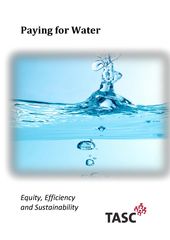TASC Paying for Water
TASC's proposals outline an equality-proofed form of water charging. The equitable model would involve 'water credits' as a subsidy for low income and special needs households combined with increasing block tariffs, so that those who use the most water, pay the most.
The Government has committed to introducing water charges and has indicated that these charges will be based on metered use. Metering is essential to ensure equity and environmental sustainability, as international best practice is for charges to be based on consumption. However, introducing flat water charges before metering is rolled out nationally would be counter-productive and undermine the new charging system from the outset. TASC is proposing a tariff structure based on volumetric charging and supplemented by a recurrent fixed charge.
Most importantly, TASC proposes the introduction of a system of graduated water subsidies, whose levels would be based on factors such as disposable household income and number of householders. Increasing block tariffs for metered use would incentivise conservation. Such a system would encourage greater water conservation and would also help support lower income households and those with special needs.
A universal 'free' allowance is a wasteful way to address ability to pay issues, as it does not take into account income or water requirements. Such an allowance is not 'free', as it is paid out of general taxation. It would in effect subsidise all households regardless of means and circumstances. It would also be an inefficient use of scarce resources, would do little to discourage over-consumption, and may mean consumers paying higher charges on use above the allowance threshold.
Charging for all water use, but providing a subsidy to low income and special needs households, is far more economically and environmentally efficient.
